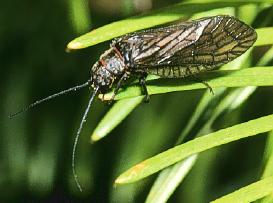Aquatic Invertebrates of Montana
Neuroptera (including Megaloptera)

Introduction
A medium sized order with less than 5000 species worldwide, about 350 species occur in North America North of Mexico, only 50 of these species are aquatic. Spongillaflies, alderflies, dobsonflies, and fishflies have aquatic larvae, snakeflies, lacewings, antlions and owlflies have terrestrial larvae. Adults are soft-bodied, weak fliers, and always terrestrial. Endopterygota- holometabolous.
Recognition
Larvae without wingpads, thoracic legs well developed, abdominal prolegs absent, antennae with more than one segment, not a beetle. Pupae- exarate, antennae with more than 11 segments, mandibles not crossed, above water and not in cases. Adults with 2 pairs of membranous non-hairy wings held roof-like over the abdomen, the wings have highly branched veins with many cross veins, tarsi 5 segmented, no cerci, antennae long and many segmented.
Life Cycle
The first instar larvae use a projection on the labrum to break out of the egg and fall or craw into the water. Megaloptera grow through about 10 larval instars and many are semivoltine. Sisyridae have 3 larval instars and may be multivoltine. The last instar larvae craw out of the water and seek pupation sites. The pupae drown if flooded. Megaloptera have a naked pupa, which is quite active. Sisyridae pupate in a double-walled silken cocoon. Adults emerge from the pupation chamber and mate. Eggs are laid above the water or in dry stream beds.
Trophic Roles
The entire order is primarily predatory as larvae and adults. Megaloptera adults are short-lived and feed little if at all. Sisyridae larvae feed exclusively on freshwater sponges, adults feed on plant nectar and pollen.
Communities
Very simple with seldom more than couple species found in any water body.
Economic Importance
Terrestrial species include many beneficial predators. Hellgrammites are frequently used for fish bait and some states require a license for their collection. Important intermediate consumers in many systems, fish food.
Zoogeography
An ancient group, the families are found on all continents. Corydalids appear to be absent from the Rocky Mountains and the Great Basin.
Collecting
Larval sisyrids are found while collecting freshwater sponges. Corydalid larvae are found in most types of benthic samples, many craw deep into crevices. Adults of some species are nocturnal and attracted to lights, but not into light traps. Adults are short-lived and generally scarce compared to the larvae.
Rearing
The pupae can be easily reared until the adults emerge, by keeping them alive is a cool place. Getting the larvae to pupae can be more difficult. Early instar larvae may be reared from eggs, but are cannibalistic.
Preservation
Larvae are best fixed in Kahle's fluid and transferred to 70% ethanol after a few days. Adults are best collected and stored in 70% ethanol, but can be killed in a killing jar and pinned, pointed, or placed in envelopes.
Taxonomy
The aquatic species are a small and fairly well studied group. Species are usually identified by male genitalia, but females, larvae and eggs are frequently identifiable to species. Corydalids may be closer to the Snakeflies (Suborder Raphidiodea) than they are to Sialidae. Most aquatic workers recognize Megaloptera as an order, most entomologists treat it as a suborder.
Reference update
- Whiting, M.F. 1994. Cladistic analysis of the alderflies of America north of Mexico (Megaloptera, Sialidae). Systematic Ent. 19:77-91.
Synopsis Of Neartic Families
- Megaloptera- larvae with normal mandibulate mouthparts, digestive tract complete,
adults with hind wings with an enlarged anal area, which is folded fanwise.
- Sialidae- alderflies, larvae < 25 mm long with a caudal filament and 7 pairs of 4-5 segmented lateral abdominal filaments, no hooked anal prolegs, the first instar may be planktonic to disperse, inhabit debris of lakes and streams, adults without ocelli.
- Corydalidae- dobsonflies, hellgrammites, fishflies, larvae > 25 mm long without caudal a filament and with 8 pairs of 2 segmented lateral abdominal filaments, hooked anal prolegs present, inhabit streams and ponds, adults with ocelli.
- Neuroptera (in the narrow sense, Suborder Planipennia)- larvae with mandibles and
maxillae elongated to form a piercing-sucking tube. Closed gut- fecal pellet discarded
when molting. Adults with hind wing without enlarged anal area.
- Sisyridae- larvae up to 8 mm long, prey on freshwater sponges in streams, lakes, or ponds.
Montana Species list
Other sites
- UD Neuroptera page
- Tree of life Neuroptera Page
- Tree of life Megaloptera Page
- CAS Neuroptera
Updated on 20 NOV 1995 D.L. Gustafson
AIM home page
dlg@rivers.oscs.montana.edu
